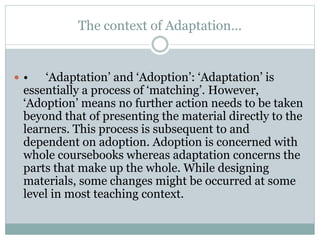Materials development
- 1. M A T E R I A L S A D A P T A T I O N ŌĆ” ŌĆ” ŌĆ” Materials developmentŌĆ”
- 2. Material Adaptation ’éŚ Materials adaptation means matching materials with the learnerŌĆÖs needs, the teacherŌĆÖs demands and administrationŌĆÖs purpose. It is the process of altering materials to improve or make them more suitable for a particular type of learner or group of learners. To maximize the appropriacy of teaching materials in context, some of the internal characteristics of a course book need to be changed to suit particular circumstances better.
- 3. The context of AdaptationŌĆ” ’éŚ ŌĆó ŌĆśAdaptationŌĆÖ and ŌĆśAdoptionŌĆÖ: ŌĆśAdaptationŌĆÖ is essentially a process of ŌĆśmatchingŌĆÖ. However, ŌĆśAdoptionŌĆÖ means no further action needs to be taken beyond that of presenting the material directly to the learners. This process is subsequent to and dependent on adoption. Adoption is concerned with whole coursebooks whereas adaptation concerns the parts that make up the whole. While designing materials, some changes might be occurred at some level in most teaching context.
- 4. ’éŚ ŌĆó External and Internal Factors: Like evaluation procedure, external and internal factors can focus on the process of adaptation. External factors comprise the overt claims made about materials, characteristics of particular teaching situations, learner characteristics, physical environment, resources, and class size. Internal factors consists of choice of topics, skills covered, proficiency level, Grading of exercises.
- 5. ’éŚ ŌĆśCongruenceŌĆÖ of Different Variables: Madsen and Bowen refer to this matching as the principle of ŌĆścongruenceŌĆÖ: Effective adaptation is a matter of achieving ŌĆ£congruenceŌĆØŌĆ”The good teacher isŌĆ” constantly striving for congruence among several related variables: teaching materials, methodology, students, course objectives, the target language and its context, and the teacherŌĆÖs own personality and teaching style.
- 6. ’éŚ ŌĆó The Scope of Adaptation: Scope means to what extent or specific areas we need to focus, for example, practicing language, texts, skills, management of classroom while adapting materials. Necessary modification and main aspects of changes are desirable in these areas.
- 7. ’éŚ Sources of Materials: Sources refers to from where we should adapt materials. Whether the materials are commercially produced and widely used internationally or they are designed at national level by ministry of Education; or if the materials are localized, produced by a team of teachers for a particular area. These things need to be kept in mind while adapting materials.
- 8. ’éŚ Availability of Resources: If the materials are available or not. Some teaching contexts are rich in resources such as coursebooks, supplementary texts, readers, computers, audio- visual equipment and consumables such as paper, pen and so on. Other context might be impoverished. While adapting materials, availability of resources is important.
- 9. Reasons for Adaptation ’éŚ Unable to fulfill the goals and objectives specified by national or local syllabuses ’éŚ fail to fulfill the goals and objectives of schools where the materials are used ’éŚ cannot be finished in the time available ’éŚ require facilities or equipment or other supporting materials that are not available ’éŚ not engaging the learnersŌĆÖ personality ’éŚ detrimental to the learnersŌĆÖ culture ’éŚ not cater for the learnersŌĆÖ interests
- 10. ’éŚ McDonough and Shaw (1993:86) have listed some of the possible areas of mismatch (ŌĆśNon- CongruenceŌĆÖ) identified by the teacher can be dealt with by adaptation are given below: ’éŚ Lack of Grammar Coverage: Sometimes, in the classroom, practices of difficult grammar points are avoided particularly. Besides, unsystematic presentation of grammar points appears while focusing on communication.
- 11. ’éŚ ŌĆóBelow Standard Comprehension Question: Comprehension questions that are put into practice are not up to the mark. ThatŌĆÖs why; answers can be lifted easily from the text with no real understanding. ’éŚ ŌĆóInauthentic Listening Passages: Listening passages sound too much like- written materials are being read out. ’éŚ ŌĆóInefficiency in Pronunciation: Teaching pronunciation is not carried out in the classroom in an appropriate way and the guidance that is provided on pronunciation is inefficient.
- 12. ’éŚ ŌĆóInappropriate Subject Matter: According to the level of learnersŌĆÖ level of learnersŌĆÖ age and intellect, the subject matter is inappropriate. ’éŚ ŌĆóCultural unacceptance: Photographs and other illustrative materials that are utilized in the classroom are culturally unacceptable. ’éŚ ŌĆóAmount of Materials: Because of time limitations, amount of materials are not definite (too much or too little) that creates mismatch with the allocation of lessons. ’éŚ ŌĆóUntrained Teachers: Teachers are unable to handle group work or role play activities with a large class. ’éŚ ŌĆóInformal Dialogues: Dialogues are unlikely to be informal or representative of everyday speech ’éŚ ŌĆóUsage Difficulty of Audio Materials: Audio materials are difficult to use in the class due to room size and technical equipment.
- 13. ’éŚ ŌĆóRarity of Various activities: Activities that are implemented in the classroom are all alike and there is too much or too little variety in the application of materials. ’éŚ All aspects of the language classroom can be covered by the few examples above include: ’éŚ ŌĆó Aspects of language use ’éŚ ŌĆó Skills ’éŚ ŌĆó Classroom organization ’éŚ ŌĆó Supplementary materials













